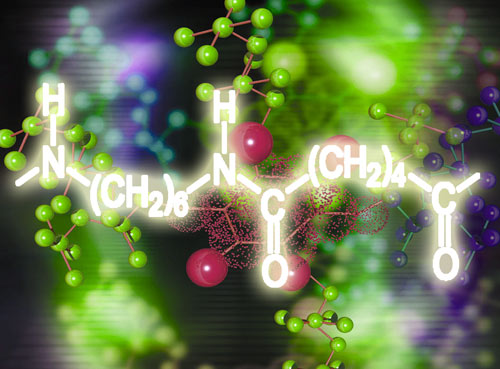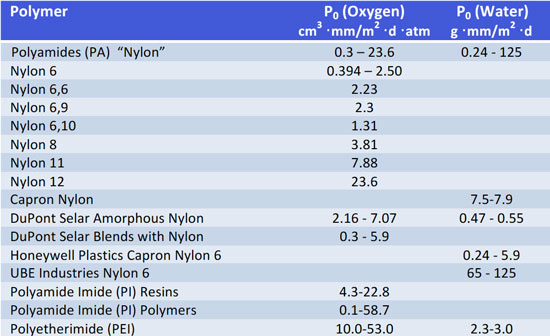


Polyamides - of which the best known brand is Nylon, was first produced in the 1930's and took just a few years to enter commercial use - the Bristles on Dr West's Miracle Tuft toothbrush was introduced. As a class, polyamides are very tough, have high abrasion resistance and offer good thermal and chemical resistance - which has led to a vast array of applications - from textiles to boil-in-the-bag food products and from electrical insulation to multiple automotive uses, mouldings and body armour.
This class of material tends to offer poor resistance to vapour flow - though specific formulations are used in safety-critical applications such as the tubing used for airbrakes, however alternate polyamide formulations are used as permeable casings for smoke cooking where vapour flow is essential.
In polyamides the polymers tend to be semi-crystalline and generally formed from repeating units which are held together by an amide link - which has the formula CONH2 and the structure shown in the diagram.
Polyamide families
Polyamide family |
Main chain |
Examples of polyamides |
Aliphatic polyamides |
Aliphatic |
Nylon PA 6 and PA 66 |
Aramids = aromatic polyamides |
Aromatic |
Paraphenylenediamine |
Polyphthalamides |
Semi-aromatic |
PA 6T = hexamethylenediamine |
There are many types of nylon available including Nylon 6 nylon 66, nylon 6/6-6, nylon 6/9, nylon 6/10, nylon 6/12, nylon 11, nylon 12.
Additional Amide characteristics
Amides can exhibit a temperature dependant and crystallinity tendency to absorb moisture from their surroundings until an equilibrium is reached and this can effect dimensional stability. However impact resistance and flexibility both tends to increase as moisture content rises though strength and stiffness below the glass transition temperature decrease. Appropriate changes to formulation can substantially reduce any negative effects due to moisture absorption.
These polymers tend to offer good chemical resistance but may be affected strong acids, alcohols and alkalis.
Amides are often used in high temperature environments especially and suitable formulations can offer sustained performance at temperatures up to around 185oC.
Polyamid permeability coefficient for oxygen and water vapour

Ref: Water vapour Permeation in Plastics, Paul E. Keller, Richard, Kouzes, January 2017. Rev 1
Typical physical properties
Tensile Strength 90 - 185 N/mm²
Notched Impact Strength 5.0 - 13 Kj/m²
Thermal Coefficient of expansion 90 - 20/70 x 10-6
Max Cont Use Temp 150 - 185 oC
Density 1.13 - 1.35/1.41 g/cm3
Click here for a press release on plastics permeability testing.
Click here for Wikipedia's Polyamide page.